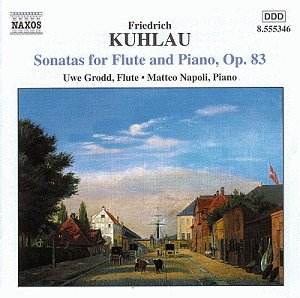If you ask any music lover which composer other than
Berg wrote an opera called Lulu, as well as one called William
Shakespeare, I wonder what they would say? The answer is Friedrich
Kuhlau, the German composer who settled in Denmark, an exact contemporary
of Weber and similarly short-lived.
He is probably best known for his piano sonatinas,
which still crop up with monotonous regularity as exam set-pieces. In
fact, he has been re-evaluated of late as an important figure in early
Danish romanticism, and the three mature sonatas gathered together on
this disc apparently earned him the enviable title ‘the Beethoven of
the flute’.
The nickname is not without its aptness, as the shadow
of the master looms large in these works. He had in fact met and shared
musical jokes with Beethoven whilst visiting Vienna in the 1820s, and
the formal layout of each piece clearly mirrors the classical structures
of Mozart and Beethoven, particularly the latter’s middle-period piano
sonatas.
It seems that Kuhlau did not play the flute himself
but sought technical advice from a friend in the theatre orchestra in
Copenhagen. The G major First Sonata seems to me most memorable
for its minor-key slow movement, built around variations on a Swedish
song ‘Sorrow’s Might’. The brilliant finale, with its Andante
sostenuto central episode, finishes with a Beethovenian flourish on
the piano.
The dramatic C minor slow introduction to the Second
Sonata cannot escape comparison either, and as the piano launches
into a vivacious C major Allegro, one is constantly reminded of all
those great models of the past. In fact the tunefulness, coupled with
the major/minor feel of so much of the material, had me in mind of Schubert,
another near contemporary.
It is fitting that the set should end with probably
the best of the bunch, a sonata employing all the dramatic elements
that its key of G minor would suggest. The hymn-like lyricism of the
slow movement is varied and contrasted as it proceeds, with the initial
calm finally being restored. The jubilant Rondo alla polacca finale
is a fitting end, offering opportunity for both players to revel in
the brilliant sparkle of the writing.
The performances by two names new to me are generally
of a very high standard, though a shade more warmth wouldn’t have gone
amiss in some of the more lyrical passages. The pianist appears to drive
much of time in some of the allegros (possibly Kuhlau reflecting his
own virtuosity on that instrument) and Matteo Napoli rises to the occasion
admirably.
The slightly resonant recording should not put anyone
off investigating this disc, another good example of Naxos allowing
us to experience unfamiliar yet rewarding territory.
Tony Haywood


